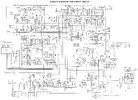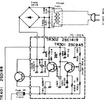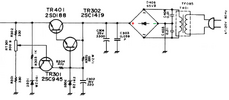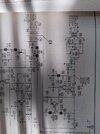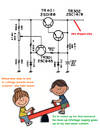I guess I could try to explain how the entire circuit functions (perhaps andy could double check me here) as it might help you track down the problem.
----------------------------------------------------------------
When the mains is plugged in, the rectified voltage initially goes through R305, is clipped by zener D302 to 16v, then that 16 volt is fed via R304 to the base of TR302. This begins to turn on TR302, which in turn, begins to turn on TR401. At this point, TR401 begins to pass voltage on to TR301's base via the divider network. Once the voltage on the wiper of RT301 reaches 6.7v (because the zener D301 keeps the emitter at 6v), it begins to turn on and pass current to ground that would otherwise be helping turn on TR302 ~ in other words, it tries to turn off TR302 a little. At this point it is a balancing act between the base of TR302 and the collector of TR301 taking current from R304. Its a feedback loop. Because the zener D301 is holding the emitter at 6v, the base wants to stay at 6.7v no matter what. Therefore, the variable resistor RT301 does not change the voltage at the base of TR301, but rather the amount of current that can go through the base, which in turn controls the amount of current through the collector. This establishes a voltage drop across TR301's collector-emitter pins that, when added to the 6v zener, should equal the 15v needed at the base of TR302. However, don't assume that just because it is not currently at 15v that TR301 is the problem, the problem could be elsewhere.
With respect to TR301, I will speak in terms of voltage as it is more intuitive for understanding the resistive divider, just know that its really the current changing at a steady base voltage.
This TR301 is like the sams schematic says, it's an error amplifier, because under normal circumstances, if the voltage on the output were to change, the voltage that would otherwise be on the wiper of RT301 would change (had it not been connected to that base lead and held at 6.7v). This changes the current through TR301's base in response to deviations in output voltage ~ it tries to keep the output the same by adjusting the regulator opposite to the changes caused by the load. For example, if the output voltage were too low (under normal circumstances), the voltage on that wiper (had it not been connected to the base) would be lower. This means less current is forced through the base as it tries to hold it at 6.7v and the transistor is trying to turn off. With this transistor pulling less current away from R304, more goes into the base of TR302, which raises the output.
------------------------------------------------------------------------
Perhaps you could test the transformer with, alternatively, a pair of small automotive turn signal bulbs in series as andy suggested just to ensure it can output that 25v under a reasonable load... But with there being 25v on the collector of TR401, I don't think that is the problem (as a lack of current capability would drop that 25v all the way back to the rectifier).
You say all the transistors are working and everything was replaced, I would then suspect the current gain of the replacement you chose for TR302 as it has a lower Hfe than the original part (and thus draws more of the precious little current available from R304). Did you also replace C302? It might also be possible that it is leaky and is gobbling up the little current available to drive TR302. Temporarily pop that cap out and see if the voltage goes up.


